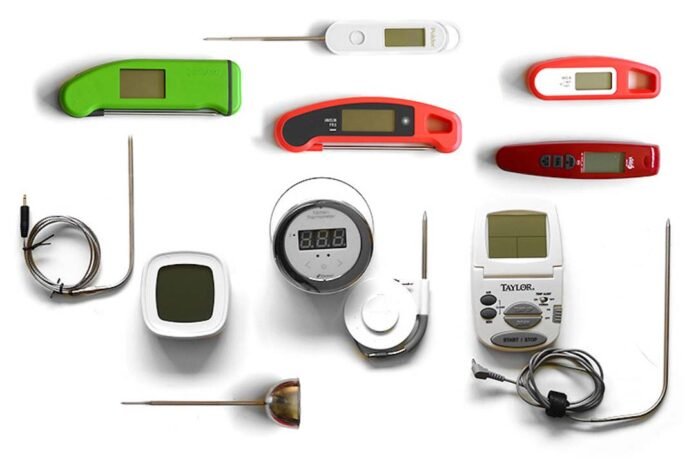Introduction to Types of Kitchen Thermometers
In the realm of culinary arts, precision is paramount. Whether you’re cooking a steak to the perfect medium-rare or crafting delicate confections, achieving the ideal temperature can make all the difference. That’s where kitchen thermometers come into play. These handy gadgets come in a variety of types, each tailored to specific cooking methods and temperature measurement needs. By understanding the different types of kitchen thermometers available, you can elevate your culinary skills and ensure consistently delicious results.
There is an Oven Thermometer for Every Kitchen
From analog to digital, Bluetooth to infrared, kitchen thermometers encompass a wide range of technologies and functionalities. Analog thermometers, with their classic dial displays, offer simplicity and reliability, while digital thermometers provide precise temperature readings with advanced features like timers and alarms. Bluetooth and wireless thermometers enable remote monitoring, allowing you to keep an eye on your cooking from afar. Combination thermometers combine multiple functions for added versatility, while IoT thermometers bring smart connectivity to your kitchen.
Temperature measurement types also vary, with direct contact thermometers offering quick readings by touching the food, and infrared thermometers providing non-invasive surface temperature measurements. Understanding the different types of kitchen thermometers and their respective strengths can help you choose the right tool for your culinary adventures. So whether you’re grilling, baking, or sous vide cooking, having the right thermometer at your disposal can take your culinary creations to new heights of perfection.
Kitchen thermometers come in various types, each designed for specific cooking methods and temperature measurement needs. Understanding the different types can help you choose the right tool for your culinary tasks.
By Data Presentation Type:
Analog Kitchen ThermometersAnalog thermometers feature a dial or gauge to display temperature readings. They are simple to use and require no batteries, but they may be less accurate than digital models.
Digital Kitchen Thermometers: Digital thermometers provide precise temperature readings on a digital display. They often offer additional features like timers and alarms, making them versatile tools for cooking and baking.
By Data Transmission Type:
Bluetooth Kitchen Thermometers: These thermometers connect to your smartphone or tablet via Bluetooth, allowing you to monitor cooking temperatures remotely. They are ideal for grilling and smoking, providing convenience and control.
Wireless Kitchen Thermometers: Similar to Bluetooth thermometers, wireless models transmit temperature data wirelessly to a receiver or mobile device. They offer flexibility and freedom of movement while cooking.
Combination Thermometers: Combination thermometers combine multiple functions, such as digital and analog displays or wireless and instant-read capabilities. They provide versatility for various cooking applications.
IoT Kitchen Thermometers: IoT (Internet of Things) thermometers connect to your home Wi-Fi network, enabling remote temperature monitoring and control via smartphone apps or voice assistants like Alexa or Google Assistant.
Instant-Read Thermometers: Instant-read thermometers deliver fast and accurate temperature readings within seconds, making them ideal for checking the doneness of meats, poultry, and baked goods.
By Temperature Measurement Type:
Direct Contact Thermometers: Direct contact thermometers measure temperature by physically touching the food or liquid being tested. They are suitable for quick temperature checks but may not be suitable for high-temperature cooking methods.
Infrared Thermometers: Infrared thermometers use infrared technology to measure surface temperature without direct contact. They are ideal for grilling, frying, and candy making, providing instant and non-invasive temperature readings.
Types of Kitchen Thermometers:
Wall Kitchen Thermometers: Wall thermometers are designed to be mounted on the wall in your kitchen, providing ambient temperature readings to help you gauge cooking conditions.
Oven Thermometers: Oven thermometers are placed inside the oven to monitor internal temperature accurately. They ensure that your oven is heating to the desired temperature for precise cooking results.
Grilling Thermometers: Grilling thermometers are designed for use on the grill or barbecue, allowing you to monitor the internal temperature of meats and poultry to prevent overcooking or undercooking.
Candy Thermometers: Candy thermometers are specialized thermometers used for making candies and confections. They provide precise temperature control for achieving the desired texture and consistency.
Sous Vide Thermometers: Sous vide thermometers are essential for sous vide cooking, ensuring that the water bath maintains a precise and consistent temperature throughout the cooking process.
Refrigerator/Freezer Thermometers: Refrigerator and freezer thermometers help you monitor the temperature inside your appliances to ensure food safety and prevent spoilage.
Meat Thermometers: Meat thermometers are designed specifically to measure the internal temperature of meats and poultry to ensure they reach safe cooking temperatures and are cooked to perfection.
Probe Thermometers: Probe thermometers feature a probe that is inserted into the food, allowing you to monitor its temperature throughout the cooking process. They are versatile tools for roasting, grilling, and smoking.
Conclusion: Elevate Your Culinary Experience with the Right Thermometer
In conclusion, choosing the right kitchen thermometer is essential for achieving culinary excellence. By understanding the various types of thermometers available and their respective features, you can enhance your cooking skills and create delicious meals with precision and confidence.
Whether you opt for an analog thermometer for its simplicity, a digital thermometer for its accuracy and convenience, or a Bluetooth thermometer for its remote monitoring capabilities, there’s a thermometer to suit every cooking style and preference. Additionally, considering factors such as temperature measurement type, such as direct contact or infrared, and specific functionalities like timers and alarms, can further tailor your choice to your culinary needs.
Investing in a quality kitchen thermometer is a worthwhile endeavor that can revolutionize your cooking experience. With the right thermometer by your side, you can ensure that your meats are perfectly cooked, your baked goods are flawlessly baked, and your candies reach the ideal temperature for smooth texture and flavor. Whether you’re a seasoned chef or an aspiring home cook, a reliable kitchen thermometer is an indispensable tool that can elevate your dishes from good to great.
So, take the time to explore the different types of kitchen thermometers available and find the one that best suits your needs. With the right thermometer in hand, you’ll be well-equipped to embark on culinary adventures and create memorable meals that delight the senses.





